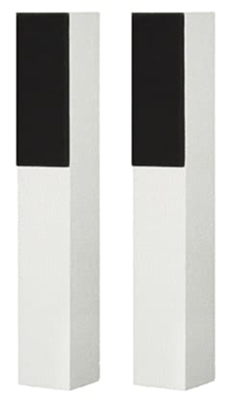Om System Audio
En anderledes historie siden 1984
Året var 1984. Dengang skulle højttalere være gigantiske og teknisk komplicerede...
System Audio introducerede sin første højttaler her, og pressen skrev forundret: "Denne højttaler sætter nye standarder". Det var ikke en højttaler som alle andre, for det var en kompakt højttaler med stor lyd. En højttaler skabt i fascination af musikken – ikke bare teknologien. En højttaler, der viste en ny vej.

Ole Witthøft, grundlægger og Head of Development

En af de første højttalere fra System Audio var System 2.

SA bruges i private hjem, studier, teatre, tv-stationer og filmstudier. På billedet ses SA2K fra år 2000.
En virksomhed med sjæl
Det var Ole Witthøft, der grundlagde System Audio A/S i 1984. Han havde længe ledt efter nogle virkelig gode højttalere, og som musiker vidste han, hvordan musik burde lyde.
…Ole forklarer: “Der var ingen højttalere, der kunne gengive musik på en levende måde. De fleste lød kedelige og unaturlige. Når lyden er så dårlig, at man hverken kan høre detaljerne eller fornemme stemningen, opdager man måske aldrig, hvor spændende musik kan være. Jeg undrede mig over, hvorfor højttalere konkurrerede om de bedste tekniske data, når det i virkeligheden er lyden, der betyder noget.”
Derfor besluttede han sig for at bygge sine egne højttalere. Inden for få år voksede efterspørgslen efter Ole Witthøfts højttalere, og i 1984 blev System Audio A/S en realitet. I dag leder Ole Witthøft fortsat udviklingsarbejdet og arbejder konstant for, at SA fortsat viser nye veje.
Forskellen kan høres af alle
SA-højttalere sælges i næsten hele verden. Vores kunder er mennesker, der elsker fantastisk lyd til musik og film, men også pladeselskaber, tv-stationer og musikere i alle aldre. Ole Witthøft forklarer: “Vores højttalere er ikke kun for eksperter, for alle mennesker har evnen til at sætte pris på god lyd. Vores opgave er at skabe forskellen, så alle kan høre den.”
En virksomhed med holdninger
Vi ønsker ikke at bidrage til forvirringen om, at højttalere kun handler om teknologi. For SA er det en selvfølge, at kvalitet skal ligge i lyden og i højttalernes evne til at være et naturligt møbel i stuen.
En forvirrende branche
Når du møder lydindustrien, vil de fleste fortælle dig, at dit anlæg skal produceres i Fjernøsten, at plastikhøjttalere næsten er gratis, og at prisen for et sådant system svarer til et par gode sko. Andre vil sige, at du bare skal lytte til musik på din computer, for det er “godt nok”.
Nogle vil hævde, at højttalere handler om design, fordi du alligevel ikke kan høre forskel. Du vil blive rådet til at læse hi-fi-magasiner, hvor “journalister” ophøjer deres personlige meninger til sandheder.
De vil fortælle dig, at lyd er en meget kompliceret sag, og at du skal læse et hi-fi-magasin for at forstå emnet. Nogle vil sige, at højttalere koster en årsløn og kræver, at du bygger din stue eller dit hus om.
Næsten alle vil fortælle dig, at du bør interessere dig for ingeniørvidenskab, for det er der, den egentlige forskel på højttalere ligger.
SA godkender ingen af disse holdninger. Vi er en virksomhed, der ikke har sine rødder i lydindustrien. Vi ønsker ikke at bidrage til forvirringen – vi vil hellere bidrage til forståelsen.
Lyd & Design
Lyd går ud over ord – det vækker følelser, skaber minder og forvandler oplevelser, som når en film bliver til ren magi.
Design, derimod, former, hvordan ting fungerer i den virkelige verden. Hos System Audio forener vi disse to sprog og skaber højttalere, der leverer enestående lyd, samtidig med at de passer naturligt ind i dit liv og dit rum.
Lyd er et universelt sprog
Vi ved, at alle mennesker har evnen til at værdsætte god lyd. Det er en menneskelig egenskab. Små børn nyder musik, før de kan læse og skrive! Det tager kun få sekunder at lytte til en orkesteropførelse og vurdere, om musikerne spiller med passion, eller om ånden mangler.
Musik følger os hele livet, forstærker og understreger stemninger og hjælper med at fastholde minder. Musik forstås og bruges af alle kulturer og kan udtrykke holdninger og følelser, hvor ord alene ikke slår til. Og hvis du nogensinde har prøvet at se en film uden lyd, ved du, at lyden er mindst halvdelen af filmoplevelsen.
Design er et universelt sprog
Det er en misforståelse at tro, at design blot handler om produktets udseende. Så enkelt er det ikke. Vi ser design som et produkts evne til at fungere i den virkelige verden. Når vi opdager, at akustikken i de fleste stuer er en af de største udfordringer for god lyd, er det designet i vores højttalere, der gør dem mindre påvirkelige af rummets akustik. Det er elektroakustisk design, men det er stadig design.
Hvis vi ikke gik op i elektroakustisk design, ville vi bare forvente, at du ændrede din stue, når du købte nye højttalere. Design handler om at tænke over, hvordan produktet fungerer bedst. Hos SA ser vi det som en opgave, hvor de tekniske discipliner går hånd i hånd med form og farve. Det gør vores tilgang til design universel, for du kan ikke diskutere, om en højttaler skal fungere i et rum – det skal den. Ligesom den skal fungere sammen med en forstærker.
Du kan heller ikke diskutere, om en højttaler lyder bedre, når den får en fremtrædende plads i stuen som et centralt møbel – for det gør den. Opgaven er at gøre højttaleren smuk nok til at fortjene en plads blandt de øvrige møbler.
Med andre ord: Du kan ikke undgå at designe et produkt – der skal altid være en tanke bag. Men du kan gøre det svært for produktet at fungere i den virkelige verden. Og dét er dårlig design. Design er et sprog. Men det tales ikke af dem, der ikke har noget på hjerte.
Stay tuned and stay inspired.

Ole Witthøft
CEO, System Audio